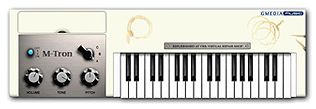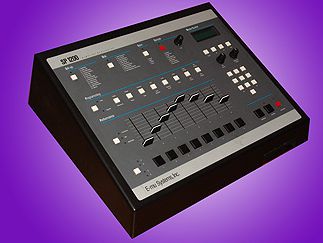Mingfei Mike Gao was an electrical engineering student in the fall of 2004. He was producing Hip Hop for six years, gaining international critical acclaim for his work as well as winning the first Project Blowed Beat Battle.
Engineers have created a tool known as the sampler that allows the user to play a prerecorded sound at any time. The sound can also be pitched, stretched, cut up, rearranged, looped, layered and reversed. Through the sampler, engineers have profoundly influenced music and the way that it is produced as well as interpreted and judged. Hip-Hop producers began sampling vinyl records, deconstructing them to create new works. With millions of records and sounds to sample from, the possibilities are endless.
Introduction
In the future, music historians will credit the engineers of our century as being some of the most influential factors in music development. They have changed not only the way music is recorded and preserved, but the very concept of music and how it is composed. According to famed French music theorist Jacques Attali, music is the organization of noise. He writes that “in the framework of information theory, the information received while listening to a note of music reduces the listener’s uncertainty about the state of the world. Euler even derived from this a definition of beauty as the faculty of discerning an order in a form” [1]. Music is therefore creating order where there is disorder, whether it is through 17th century tonal music or the drum patterns heard on today’s dance floors. Modern composers not only create order by writing notes and rhythms, which define frequencies of sounds to be played in a pattern in time, but work with the actual sounds themselves to create music. The sampler, a tool invented by engineers, has given the contemporary musician the power to manipulate and organize sound in ways never before imagined.
When I Was Your Age
In essence, the sampler allows a musician to store sounds that can be played back on command. Though this seems like a trivial function, any instrument can be thought of simply as a device that makes a sound upon user input. An electric keyboard is often merely a sampler. A real piano is recorded or sampled into a Read Only Memory chip and when a key is pressed, the corresponding sample is triggered and a piano note is heard. The first commercial sampler, called the Mellotron (see Fig. 1), was invented in 1963 and utilized analog tape technology. The Beatles used it to reproduce a flute in their famous recording, “Strawberry Fields Forever” [2]. Because it relied on a mechanical motor, analog tape technology generally had limitations on speed and response: there was usually a delay between the triggering event and the note’s sounding. Some mechanical motors’ failure to maintain a constant velocity caused a phenomenon called tape “wah,” which was a fluctuation of pitch. Although some may view these characteristics as engineering flaws, others feel that it adds to the distinctive sound of the instrument. In fact, a company called G-Force has released a sampler that emulates the vintage Mellotron’s characteristics (see Fig. 2).
Although the use of analog tape in the Mellotron had limitations, its invention was an engineering milestone in music. A layer of gamma iron oxide (Fe2O3), or other easily magnetized material, was coated on a plastic base, creating a reel of tape. During recording, the tape is passed under a recording head, which magnetizes the material in a pattern that corresponds to the sound being recorded [3]. For playback, the tape is passed through a playback head with sensitive electronics that detect the pattern as a varying magnetic field. With the advent of magnetic tape recording, sounds could now be chopped up and rearranged by manually cutting the tape and pasting it back together, a process known as tape splicing. Sounds could be played in reverse, or sped up and slowed down by altering the direction and speed at which the reels of tape would spin.
This technology also gave the composer the power of multi-track recording. Composers could record each instrument individually on independent tracks on a tape and overlay them. Gone were the days of entire jazz bands recording albums in one take. Mistakes could be corrected, and one musician could play multiple instruments on a recording. Analog tape sampling “has fundamentally changed the creative process in the popular recording studio. Rhythm tracks may be recorded in one location, while vocals and other elements are added later at a studio halfway around the world” [3].
In the early 1940s, a form of music emerged known as “musique concrete.” French composers such as Pierre Schaeffer and Pierre Henry began to question the nature of sound and experimented with the creative use of tape recording and manipulation. Schaeffer invented the tape loop, a technique involving the splicing of the end of a section of tape to the beginning. This would create an indefinitely repeating section of tape, useful for rhythmic backing tracks.
Digitization
Commercial digital recording emerged in the early 1970s as an alternative to analog tapes. With digital samplers, sounds were stored in tiny memory chips and could be triggered without the mechanical activation of reels, resulting in relatively no delay. Rather than storing a magnetic replica of the audio signal on a physical medium, sound waves were broken down into a discrete set of numbers representing the amplitude of the wave at different points in time. “It is the numbers that are stored-not the signal itself. As long as the numbers can be read back accurately, the original signal can be recovered to the extent allowed by the sampling rate and the precision of the numbers themselves” [4]. The sampling rate determined the frequency at which the sound wave would be examined and the amplitude stored. Most CD audio is digitized at 44.1 KHz, meaning that the sound is examined 44,100 times a second with an amplitude value noted each time. This can be likened to a camera taking a picture of the sound 44,100 times a second to create a motion picture of a sound wave. Each value of amplitude is assigned a number depending on the resolution of the sample. For example, with 16 bit resolution, amplitudes are stored using 16 binary numbers and can take values ranging from 0 to 65,535. Music can then be conceptualized as a series of numbers representing waves of sound, rather than notes in the traditional 12-tone scale. If the numbers are randomized, the result is noise, the lack of order.
The first commercial digital sampler, the Fairlight CMI, was released in 1979 with a retail price of $25,000 and a sampling rate of 10 KHz with 8-bit resolution. To put this in perspective, CD audio is sampled at 44,100 KHz with 16-bit resolution. Low bit rates had a crunchy sound, which made the samples “grittier.” The 12 bit EMU SP-1200 sampler, although first released in 1988, remains popular and has kept its value even today. Artists attributed the SP-1200 as being able to produce hard, dirty sounding drums [5]. “Jel,” a SP-1200 wielding artist, has even gained international attention for a style based on the 12 bit resolution. In fact, he pays tribute to the vintage sampler on his album, “10 Seconds,” so named due to the limited memory and sampling time of the SP-1200. His sound can be described as low-fidelity, with not only drums but all instruments sampled through the SP-1200. Much like in the case of the Mellotron, technical limitations caused engineers to inadvertently create a distinct and desirable characteristic in an instrument.
As samplers such as the SP-1200 (see Fig. 3) became mainstream and affordable in the 1980s, a new, distinctive form of music emerged from urban America resultant from its use: Hip-Hop. Inner-city youths who could not afford instruments sampled the sounds that they needed from vinyl records to craft the “beats,” or the music that served as the backing track for rap vocalists. Due to the mass production and proliferation of the vinyl record medium, a seemingly endless supply of records and sounds were at the fingertips of anyone who had access to a sampler. Much like sound could be broken down into a discrete set of numbers, music could also be deconstructed and recreated with pre-existing sounds from records. Instead of hiring a studio musician to play a saxophone line, for example, a sample-based composer could lift several melodies from a record, cut them up, change the pitch, and place them at the right time. This would in effect give the artist the freedom to create their vision without traditional musical limitations.
The pitching of a sample involves playing the same sound at a different speed, and thus changing the length and timbre of the sound. Timbre, also called the tone color of sound, is a qualitative characteristic of sound defined by the shape of the sound waves. It is the reason that a piano and a flute playing the same note at 440 Hz sound dramatically different. Sampling has opened the door to the creation of timbres inexpressible by normal instruments or voices. For example, Grammy award winning Hip-Hop producer Kanye West made famous a style of sampling vocals from soul songs that are sped up, creating timbres unrepeatable by real vocalists.
Often a sample will have to be sped up or slowed down to be rhythmically in time with another sample. As stated above, this will invariably change the pitch of the sample, placing each track out of tune. To address this, the sampler manufacturer Akai invented the time-stretch. Theoretically, small chunks of sound are removed evenly from a sample to increase the speed and added to slow the sample down. As long as the speed is not drastically changed, the timbre of the sound will appear the same. Instrumentation recorded for one song and tempo can be time-stretched and reused. Composers who change their mind about the tempo of an instrument have the ability to time-stretch rather than rerecord.
Not only have engineers provided new ways and techniques in creating music but have also, in turn, affected the codes and syntax of music. According to Jacques Attali, every piece of music is judged according to the complexity and quality with which it is executed according to a code. He writes that “the transition from Greek and medieval scales to the tempered and modern scales can be interpreted as aggression against the dominant code.” This process of aggression can only succeed if the existing code has already become weak through use” [1]. Today’s Hip-Hop producers often judge each other based on characteristics such as sound quality and the rarity of the records being sampled. This shows that the sample-based music of today is being judged by factors that previously did not even exist. Engineers have given musicians new ways of expression, which in turn, has affected the criteria upon which the music is judged.
Conclusion
Through the sampler, engineers have given the average person powers in organizing sound and creating music that Beethoven would have considered superhuman. Sounds can be pitched, stretched, cut up, moved around, reversed, looped, and layered. With over half a century of recorded audio to sample from, the possibilities are endless. Despite sampling’s widespread use in today’s popular music, however, it remains often misunderstood and underappreciated. Many think of sampling as stealing entire songs rather than taking a single note from a saxophone solo. There are indeed, examples of both. Regardless, sampler-wielding composers, more specifically Hip-Hop producers, have gained increased legitimacy and influence in the music industry. Recently, the production duo “Neptunes” sold a beat for $2 million, and the producer/rapper Kanye West had the number one selling album in America. The sampler has had a profound influence on the music of today, and will continue to influence the sounds of tomorrow.
References
[1] J. Attali. “Noise: The Political Economy of Music”. Paris: Presses Universitaires de
France, 1977.
[2] P. White. “Strawberry Feel.” Sound on Sound Magazine, pp. 22, Dec. 2000.
[3] J.M. Eargle. Music, Sound and Technology. New York: Van Nostrand Reinhold, 1995.
[4] P. Manning. Electronic and computer music. New York : Oxford University Press, 2004.
[5] “Sampler (musical instrument) History.” Art History Club. Internet: http://www.arthistoryclub.com/art_history/Sampler_(musical_instrument). [Oct. 2, 2005].
[6] “Analog Tape Recorders.” UCSC Electronic Music Studios Documents. Internet: arts.ucsc.edu/ems/music/equipment/analog_recorders/Analog_Recorders.html, [Oct. 2, 2005].






